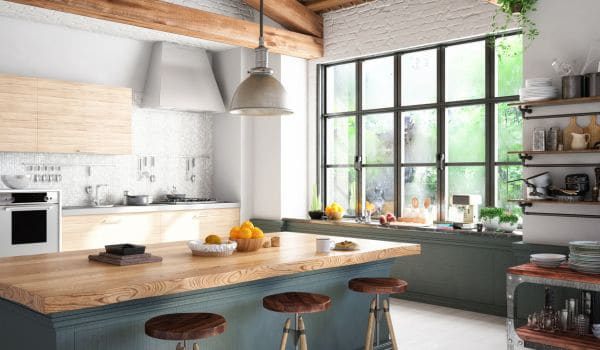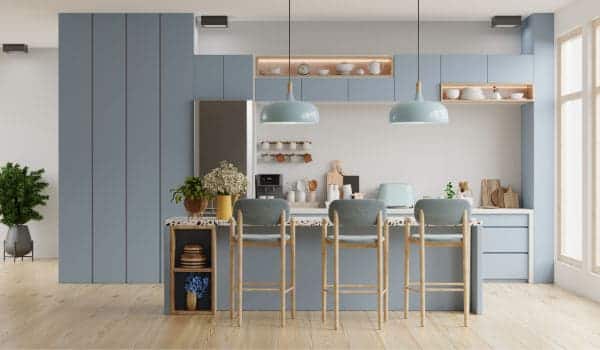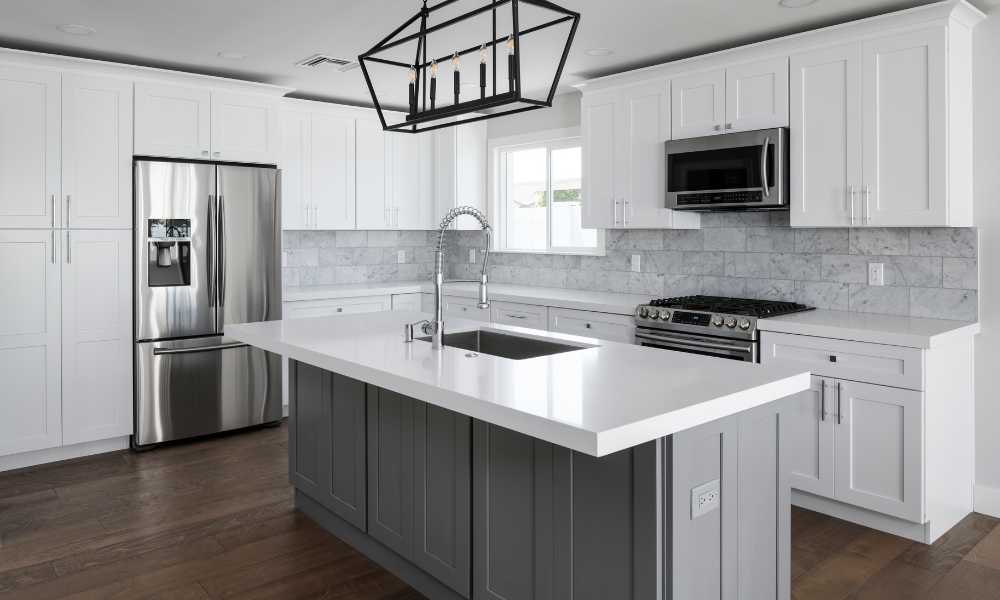Embarking on a kitchen renovation journey sparks excitement and anticipation, as homeowners envision a revitalized space that aligns with their lifestyle and aesthetic preferences. Titled “How Much Does A Kitchen Renovation Cost,” this exploration delves into the financial aspects of turning kitchen dreams into reality.
A kitchen renovation transcends mere cosmetic enhancements; it is a strategic investment with multifaceted implications. Beyond the sentimental value of family gatherings and cherished memories, the decision to renovate is rooted in the need to modernize outdated spaces, enhance functionality, and boost energy efficiency.
Understanding the costs involved is paramount in ensuring a successful and sustainable transformation. The financial investment in a kitchen renovation is not solely about creating a visually appealing environment; it necessitates a careful evaluation of budgets, available financial resources, and the long-term value it brings to the home.
As homeowners embark on this transformative process, they encounter various cost factors. Material choices, labor expenses, and the scope of the renovation project all play pivotal roles. A well-informed approach involves a realistic assessment of individual priorities, balancing desires with financial constraints.
Factors Influencing Kitchen Renovation Costs

Size and Layout of the Kitchen
The dimensions and configuration of a kitchen wield a direct influence on renovation costs. Larger spaces necessitate more materials, extended labor hours, and additional features, contributing to heightened expenses. A spacious kitchen entails a greater quantity of flooring, cabinetry, and countertops, amplifying material costs. The increased square footage also demands more extensive labor, potentially involving additional professionals and time. Moreover, larger kitchens often involve the incorporation of supplementary features or appliances, further escalating overall expenses. Recognizing these correlations between size, configuration, and costs is crucial for homeowners in effectively budgeting and planning their kitchen renovations.
Quality and Type of Materials Used
Material choices wield a substantial influence on overall renovation costs. Opting for high-quality materials, while incurring higher initial expenses, often pays dividends in long-term durability and enhanced aesthetic appeal. Superior materials, such as hardwood flooring or premium countertops, not only elevate the overall look and feel of the kitchen but also contribute to longevity, reducing maintenance and replacement costs over time. Balancing upfront costs with the long-term benefits of durability and aesthetics is a critical aspect of strategic decision-making in kitchen renovations.
Scope of the Renovation Project
The extent of a kitchen renovation, whether a complete overhaul or partial upgrade, plays a pivotal role in cost dynamics. Comprehensive renovations involving a full redesign, structural changes, and updated appliances typically incur higher labor and material expenses. In contrast, minor updates, such as cabinet refacing or cosmetic enhancements, generally involve lower costs. Homeowners must carefully assess the scope of their project, balancing their desired improvements with budget considerations to achieve a tailored renovation plan that meets both their needs and financial constraints.
Geographic Location and Local Market Trends
Regional variations in kitchen renovation costs stem from differences in living expenses, service demand, and local market trends. Higher living costs in certain areas may elevate labor and material prices, influencing the overall budget. Additionally, fluctuations in demand for renovation services and adherence to local market trends impact pricing dynamics. Recognizing these regional nuances is crucial for homeowners to accurately anticipate expenses, enabling a more informed and effective budgeting process tailored to their specific location and its unique economic landscape.
Contractor and Labor Costs
Hiring professional contractors significantly influences the budget of a kitchen renovation. Labor costs constitute a substantial portion, varying based on the contractors’ skill levels and experience. While seasoned professionals may demand higher hourly rates, their expertise often ensures efficient and high-quality work, potentially reducing the need for costly corrections. Obtaining multiple quotes from different contractors is imperative, allowing homeowners to assess competitive pricing, evaluate skill levels, and negotiate favorable terms. A comprehensive selection process, considering both cost and expertise, is essential for achieving a balance between quality workmanship and staying within budget constraints during the intricate process of kitchen renovation.
Breakdown of Costs

Cost of Materials
Cabinetry
Explanation of how the choice of cabinets, including materials and design, contributes to the overall cost.
Countertops
Discussion on various countertop materials and their associated costs.
Flooring
Overview of flooring options, emphasizing how the material and installation affect the budget.
Appliances
Examination of how the selection of appliances impacts the budget, considering energy efficiency and brand choices.
Lighting Fixtures
Discussion on the cost factors related to lighting, including fixtures and installation.
Labor Costs
Demolition and Removal
Explanation of costs associated with removing existing structures and materials.
Installation of New Elements
Overview of the labor involved in installing new components, such as cabinets, countertops, and appliances.
Plumbing and Electrical Work
Discussion on the costs of hiring professionals for plumbing and electrical tasks during the renovation.
Painting and Finishing Touches
Examination of the labor and material costs related to painting and adding finishing touches to the renovated space.
Average Costs and Budgeting

National average costs for kitchen renovations:
Understanding the national average costs serves as a crucial starting point for homeowners planning a kitchen renovation. These figures provide a general benchmark, allowing individuals to gauge the scale of their project in comparison to broader trends in the market. However, it’s essential to recognize that these averages may vary significantly based on factors such as project complexity, materials used, and geographic location.
Regional variations in costs:
Delving deeper into budget considerations, and acknowledging regional variations in costs is imperative. Different areas may exhibit unique economic landscapes, influencing the prices of labor, materials, and permits. Homeowners should conduct thorough research to understand how their specific location might impact the overall budget for their kitchen renovation.
Budgeting tips and considerations:
Crafting a comprehensive budget involves more than just estimating costs. Homeowners must consider various factors, including design preferences, the extent of the renovation, and the desired level of quality. Implementing effective budgeting tips, such as prioritizing needs over wants and accounting for unforeseen expenses, can help ensure financial stability throughout the renovation process.
Cost-Saving Strategies

DIY options for certain aspects:
Embracing do-it-yourself (DIY) options for specific aspects of the kitchen renovation can significantly reduce costs. Homeowners with the necessary skills and time can take on tasks like painting, simple installations, or even cabinet refinishing, contributing to overall savings.
Comparison shopping for materials and appliances:
Cost-saving begins with strategic shopping. By comparing prices for materials and appliances across various suppliers, homeowners can identify the best deals without compromising on quality. This approach allows for the creation of a cost-effective yet high-quality kitchen space.
Negotiating with contractors:
Engaging in negotiations with contractors can yield favorable terms and pricing. Homeowners should be proactive in discussing project details, timelines, and payment structures. A collaborative and transparent relationship with contractors can lead to cost savings and a more efficient renovation process.
Repurposing existing elements:
Renovation doesn’t always necessitate starting from scratch. Repurposing existing elements, such as cabinets, hardware, or even appliances in good condition, can contribute to substantial cost savings. This environmentally friendly approach also adds a touch of character to the new kitchen space.
Hidden Costs and Contingency Planning

Unforeseen issues during the renovation process:
Despite meticulous planning, unforeseen issues can arise during a kitchen renovation. From structural surprises to permit delays, these unexpected challenges can impact both the timeline and budget. Homeowners should be prepared for such contingencies and remain flexible in adapting to evolving circumstances.
Importance of setting aside a contingency budget:
Recognizing the unpredictable nature of renovations, setting aside a contingency budget is a fundamental aspect of financial planning. Allocating a percentage of the overall budget to cover unforeseen expenses ensures that homeowners can navigate unexpected challenges without derailing the entire project. This foresight contributes to a more resilient and stress-free renovation experience.
Return on Investment
How a kitchen renovation can add value to a home:
Undertaking a kitchen renovation not only enhances the aesthetic appeal and functionality of a home but can also significantly increase its overall value. A well-designed and modern kitchen is often a key selling point for potential buyers. Upgraded appliances, quality finishes, and a thoughtfully planned layout can contribute to a positive perception of the property. Beyond resale value, a renovated kitchen can also enhance the homeowners’ daily living experience, making it a worthwhile investment.
Calculating the potential ROI:
Assessing the return on investment (ROI) for a kitchen renovation involves understanding how the project’s cost aligns with the potential increase in the home’s value. Homeowners can calculate ROI by comparing the total cost of the renovation to the expected increase in property value. It’s important to consider factors such as the local real estate market, the quality of the renovation, and the preferences of potential buyers. While ROI can vary, a well-executed kitchen renovation generally proves to be a sound financial decision, offering both immediate enjoyment and long-term value.
Conclusion
Embarking on a kitchen renovation is a multifaceted endeavor that requires careful consideration of costs, budgeting strategies, and potential return on investment. National average costs and regional variations provide essential benchmarks, guiding homeowners in shaping realistic budgets. Implementing cost-saving strategies, including DIY options, comparison shopping, negotiating with contractors, and repurposing existing elements, allows for a more economically sustainable project. However, the unpredictable nature of renovations underscores the importance of hidden costs and contingency planning. Allocating a contingency budget safeguards against unforeseen challenges, ensuring a smoother and more resilient renovation process. Lastly, understanding the potential return on investment emphasizes the long-term value of a well-designed kitchen, both in terms of enhanced living quality and increased property value. Ultimately, a thoughtful and strategic approach to kitchen renovations can lead to a successful and rewarding transformation of the heart of the home.





